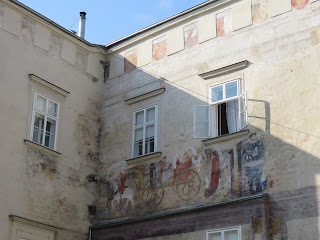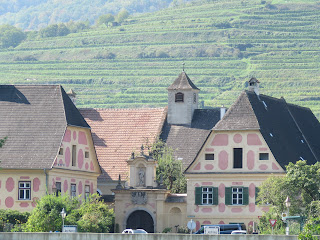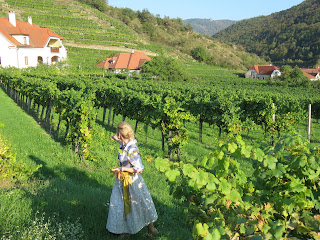On Tuesday morning we awoke to lovely views of the river and
the old town of Stein, which is municipally a part of Krems. Stein is actually
the oldest town in Austria, and Krems is not too far behind it. Stein was
originally a port town on the river, and Krems, the old town being a little
farther away, was the fortified area.
Our walking tour in the morning took us to the old town of
Krems, through the city gates and around some of the tiny 'gassen', tiny alleys
or laneways that are so common in medieval communities. Krems dates back to
around 1000, but there have been settlements here much longer - the oldest
grave in Austria was found here dating back 27,000 years! In 2000 it was added
to the UNESCO World Heritage list.
 |
| Ornate plasterwork on the facades of some of the houses |
 |
| Old wall painting depicting scenes from life in the town |
Along with the ornate plaster on many buildings, our guide showed us some drawing done on the outside of buildings in the method of sgraffito, which is drawn into the wet layer of plaster and then painted as the artist likes. This is, of course, the precursor to modern day graffiti, but nowadays they don't take quite as much pride in their finished product.
After the tour we had some free time so we wandered around a
little more, and then decided to walk back to the ship. We found a few
interesting views along the way:
 |
| In the Stadtpark |
 |
| Along the river promenade. Leaves are just staring to turn on some plants |
 |
| MS Savor docked at Stein |
Once everyone was back on board, we started our cruise
through the Wachau Valley, which stretches from Krems to the small town of
Spitz. We were stopping at Spitz to pick up the intrepid bike riders who chose
to ride through the valley rather than sit comfortably on the sun deck watching
the little towns - and their huge churches - go by. At the same time we had the
option of visiting a local winery to taste the particular local products which
have been gaining worldwide popularity - Grüner Veltliner and Riesling. (Monica has been drinking Grüner Veltliner for a while now - it is very similar to Sauvignon Blanc.)
The Wachau Valley has a particular microclimate that is very
good for vineyards, along with the steep limestone hills for growing these
white grape varietals. It looks very much like the Mosel but the hills are not
as high.
We knew we would be passing the tiny village of Durnstein on our way, which is one of the most picturesque spots on the whole Danube. As it turns out, it was also a very important site economically for the Austrian empire during the Crusades. The ruined castle high up on the hill was used to imprison Richard the Lionheart for about 6 months. He was actually held for ransom there, and once it was paid, the empire had enough money to build a fortification wall around Vienna!
We continued to sail along, every so often hearing our bikers calling to us from the water's edge.
 |
| Our bikers waving from a beach. They had to ride 20 km, but, unlike the other side of the river, they didn't have hills like we did when we rode. |
For our winery visit, our group went to the Johann Donabaum Winery.
It is a small family-run winery with the grandson of the founder now the head
winemaker. Since he took it over about 20 years ago, he has put the winery
among the top 10 in the Wachau Valley, exporting to a number of countries,
including Canada. His wife was our guide - considering that this is only the
third time she had hosted a tasting, she was really great; wonderful sense of
humour and very interactive with the guests. In fact, one of our gentlemen was
asking about harvesting the grapes - which is done by hand on the steeper
slopes - and she suggested that if he wanted to help next year, he would need
to start working out as soon as he got home! That certainly drew guffaws from
the rest of us! But then, she wasn't kidding about how strenuous it is to carry
baskets loaded with 40 kg (about 100 lb) of grapes from a maximum grade slope
down to the truck. They had an intern working with them a couple of summers ago
who ran the New York City marathon after the season ended, and came in second!!
The town of Spitz is very small, but we did find one symbol
on a doorway that we hadn't found anywhere else. The grapevine wreath hanging
on this door indicates that there is what the Austrians call a 'Heurigen'
there. Heurigen are little restaurants that winemakers were allowed to have to
sell some of their wine locally, served with cold foods only. These still exist
now, and the grapevine wreath is the quick way to see if the winery has one. Of
course, the larger producers now can't have a heurigen, so Johann had to close
his grandfather's little place when he decided to get serious about the wines.
Apparently his grandfather was rather skeptical about the idea, but the rest,
as they say.....
 |
| The town church - they all look like cathedrals around here! |
 |
| The grapevine wreath that indicates there is a heurigen here. |
 |
| One of the vineyards right near the river |
As we sailed further westward along the Danube, we noticed
that there were lots of rocky beaches along the river that shouldn't really
have been there. This didn't bode well for the update we were going to get
before dinner:
And we were right. At our briefing, our cruise director Maggie
gave us the bad news - we were facing a deviation from the itinerary once we
got to Passau. The water levels remained at an all-time low near Pfelling, just
west of Passau, and the German authorities had told the cruise companies that
there would be no ships sailing through that area. Instead of being able to
enjoy some scenery we hadn't seen before, and the better part of a day of
cruising time on Thursday, we would be touring out of Passau by bus and then on Friday taking our buses to Nürnberg for tours and to stay overnight at a hotel so we wouldn't miss
our train to Berlin on Saturday morning.
Lots of upset people around us, but it wasn't like there was
any surprise. For anyone who had noticed that every time rain was forecast, it
didn't fall, there was no way that the river was going to get any deeper for
us. Of course it was disappointing not to have more time on the cruise, but we
knew that Tauck would do whatever they could to provide as close as possible to the same
level of experience for us until we could get back to the program in Berlin. We'd just have to wait for further details.
As this was a major talking point for much of the evening,
Larry found himself explaining how the train ticketing for the group probably
worked, and how it would be impossible to expect the Adlon Kempinski Hotel, one
of the most prestigious and sought-after addresses in all of Berlin, to have 60
hotel rooms available a day early at the drop of a hat.
Just to make sure we could have some more of the cruising
experience, we went up to the sun deck once we left Spitz and watched the towns
and villages (and church silhouettes) go by for a while. We sat through the
transit of one lock and then turned in. We had a relatively early wake-up for
our all-day tour to the Salzkammergut from Linz.













































No comments:
Post a Comment